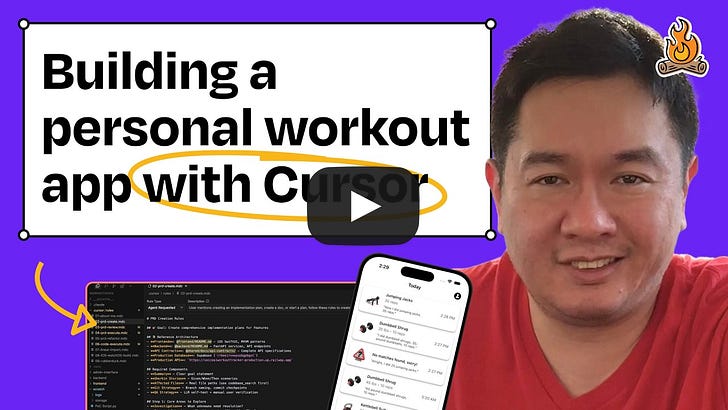How I built an Apple Watch workout app using Cursor and Xcode (with zero mobile-app experience) | Terry Lin
How I built an Apple Watch workout app using Cursor and Xcode (with zero mobile-app experience) | Terry Lin🎙️ How a product manager used Cursor, Xcode, and a structured AI workflow to build a voice-powered fitness tracker that works seamlessly across iPhone and Apple WatchWhy is this in your inbox? Because How I AI, hosted by Claire Vo, is part of the Lenny’s Podcast Network. Every Monday, we share a 30- to 45-minute episode with a new guest demoing a practical, impactful way they’ve learned to use AI in their work or life. No pontificating—just specific and actionable advice. Prefer to skip future episode drops? Unsubscribe from How I AI podcast notifications here.  Brought to you by:Paragon—Ship every SaaS integration your customers want Miro—A collaborative visual platform where your best work comes to life Terry Lin is a product manager and developer who built Cooper’s Corner, an AI-powered fitness tracking app that works across iPhone and Apple Watch. Frustrated with traditional fitness apps that require extensive setup and manual logging, Terry created a solution that lets users simply speak their exercises, weights, and reps. The app automatically structures this data and provides analytics on workout consistency and progress. In this episode, Terry shares his vibe-coding process using Cursor and Xcode and explains how he optimizes his codebase for AI collaboration. What you’ll learn: 1. How Terry built a voice-powered fitness tracker that works across iPhone and Apple Watch 2. His “dual-wielding” workflow, using Cursor for coding and Xcode for building and debugging 3. Terry’s three-step process for working with AI: create, review, and execute 4. Why optimizing your codebase for AI collaboration can dramatically improve productivity 5. How to use index cards and GPT-4 to rapidly prototype mobile interfaces 6. A technique for “vibe refactoring” that keeps code organized and optimized for both human and AI readability 7. His “rubber duck” technique to better understand generated code and improve your learning process Where to find Terry Lin:LinkedIn: https://www.linkedin.com/in/itsmeterrylin/ GitHub: https://github.com/itsmeterrylin Where to find Claire Vo:ChatPRD: https://www.chatprd.ai/ Website: https://clairevo.com/ LinkedIn: https://www.linkedin.com/in/clairevo/ In this episode, we cover:(00:00) Introduction to Terry and his fitness tracker app (02:30) Demo of the voice-powered workout tracking across devices (06:40) Analytics and history views for tracking consistency (07:20) Dual-wielding Cursor and Xcode for mobile development (09:05) Building a v1 using AI tools (11:19) A three-step AI workflow: create, review, execute (19:38) Token conservation and vibe refactoring explained (23:25) Optimizing file sizes for better AI performance (25:28) Using “rubber duck” rules to learn from AI-generated code (28:13) Prototyping with index cards and GPT-4 (31:20) Human creativity and the last 10% (32:29) Lightning round and final thoughts Tools referenced:• Cursor: https://cursor.sh/ • Xcode: https://developer.apple.com/xcode/ • GPT-4: https://openai.com/gpt-4 • UX Pilot: https://uxpilot.ai/ • Figma: https://www.figma.com/ • Linear: https://linear.app/ Other references:• Apple UI Kit: https://developer.apple.com/design/human-interface-guidelines/ Production and marketing by https://penname.co/. For inquiries about sponsoring the podcast, email jordan@penname.co. Invite your friends and earn rewardsIf you enjoy Lenny's Newsletter, share it with your friends and earn rewards when they subscribe. |
Similar newsletters
There are other similar shared emails that you might be interested in:
- How this former NYT columnist uses ChatGPT to brainstorm ideas, do research, and find the perfect metaphor | Farha…
- Vibe coding a 3D multiplayer game in 15 minutes—with no game dev experience | Cody De Arkland (Senior Director of …
- A designer’s guide to AI: Building in Cursor (instead of Figma) lets you prototype 10x faster, simplifies collabor…

